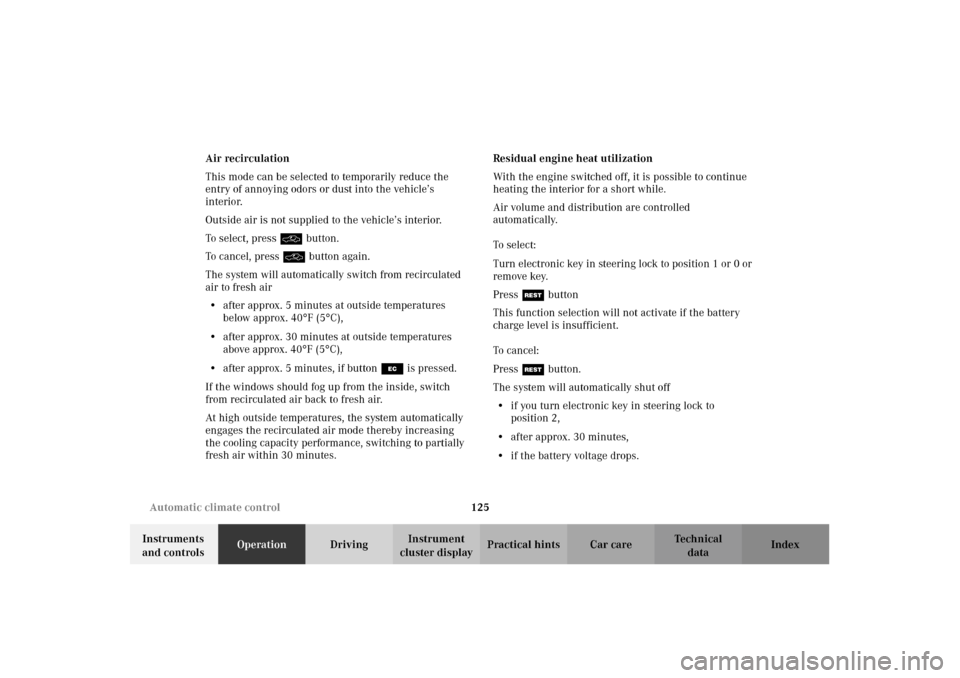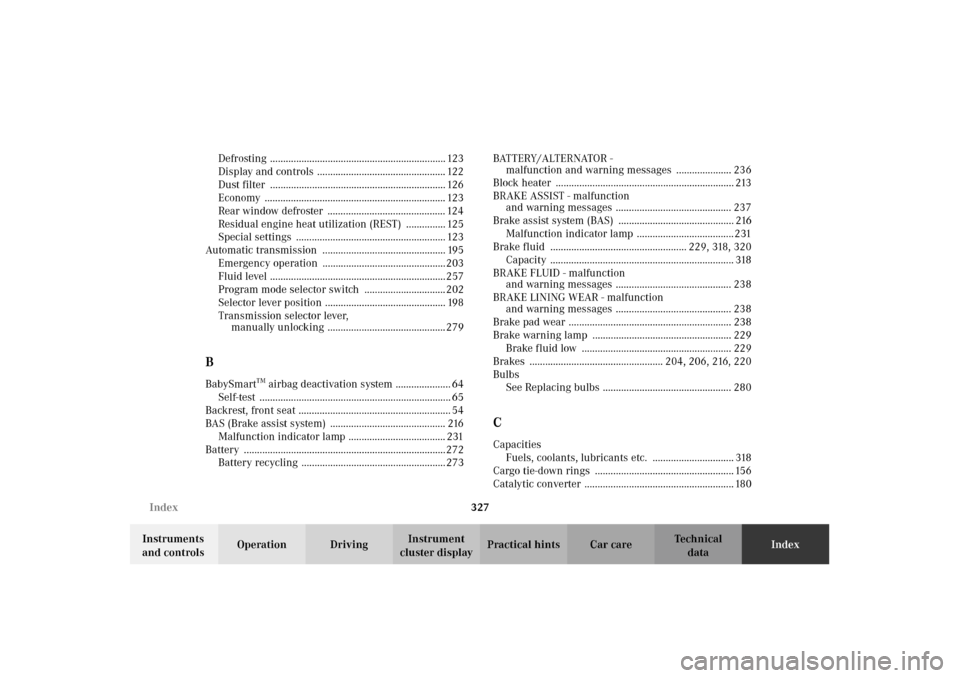2002 MERCEDES-BENZ CLK430 CABRIOLET battery capacity
[x] Cancel search: battery capacityPage 128 of 346

125 Automatic climate control
Technical
data Instruments
and controlsOperationDrivingInstrument
cluster displayPractical hints Car care Index Air recirculation
This mode can be selected to temporarily reduce the
entry of annoying odors or dust into the vehicle’s
interior.
Outside air is not supplied to the vehicle’s interior.
To select, press O button.
To c a nc el, pr ess O button again.
The system will automatically switch from recirculated
air to fresh air
•after approx. 5 minutes at outside temperatures
below approx. 40
°F (5
°C),
•after approx. 30 minutes at outside temperatures
above approx. 40
°F (5
°C),
•after approx. 5 minutes, if button S is pressed.
If the windows should fog up from the inside, switch
from recirculated air back to fresh air.
At high outside temperatures, the system automatically
engages the recirculated air mode thereby increasing
the cooling capacity performance, switching to partially
fresh air within 30 minutes.Residual engine heat utilization
With the engine switched off, it is possible to continue
heating the interior for a short while.
Air volume and distribution are controlled
automatically.
To s e l e c t :
Turn electronic key in steering lock to position 1 or 0 or
remove key.
Press T button
This function selection will not activate if the battery
charge level is insufficient.
To c a n c e l :
Press T button.
The system will automatically shut off
•if you turn electronic key in steering lock to
position 2,
•after approx. 30 minutes,
•if the battery voltage drops.
J_A208.book Seite 125 Donnerstag, 31. Mai 2001 9:35 09
Page 215 of 346

212 Driving instructions
Technical
data Instruments
and controlsOperationDrivingInstrument
cluster displayPractical hints Car care Index
If the vehicle is parked after being driven on salt treated
roads, the braking efficiency should be tested as soon as
possible after driving is resumed while observing the
safety rules in the previous paragraph.Winter driving
Have your vehicle winterized at your authorized
Mercedes-Benz Center before the onset of winter.
•Change the engine oil if the engine contains an oil
which is not approved for winter operation. For
viscosity (SAE/CCMC class) and filling quantity, see
page 318.
•Check engine coolant anticorrosion/antifreeze
concentration.
•Additive for the windshield washer and headlamp
cleaning system: Add MB Concentrate “S” to a
premixed windshield washer solvent/antifreeze
which is formulated for below freezing temperatures
see page 259.
•Test battery: Battery capacity drops with decreasing
ambient temperature. A well charged battery helps
to ensure that the engine can be started, even at low
ambient temperatures.
•Tires: We recommend M+S rated radial-ply tires on
all four wheels for the winter season. Observe
permissible maximum speed for M+S rated
radial-ply tires and the legal speed limit.
Wa r n i n g !
If the vehicle becomes stuck in snow, make sure
that snow is kept clear of the exhaust pipe and
from around the vehicle with engine running.
Otherwise, deadly carbon monoxide (CO) gases may
enter vehicle interior resulting in unconsciousness
and death.To assure sufficient fresh air ventilation, open a
window slightly on the side of the vehicle not
facing the wind.
J_A208.book Seite 212 Donnerstag, 31. Mai 2001 9:35 09
Page 275 of 346

272 Battery
Technical
data Instruments
and controlsOperation DrivingInstrument
cluster displayPractical hintsCar care Index
If a tire constantly loses air, it should be inspected for
damage.
The spare tire should be checked periodically for
condition and inflation. Spare tire will age and become
worn over time even if never used, and thus should be
inspected and replaced when necessary.Battery
Important!
Battery replacement information:
The maintenance-free battery is located in the trunk
under the trunk floor.
The service life of the battery is dependent on its
condition of charge. The battery should always be kept
sufficiently charged, in order to last an optimum length
of time.
Wa r n i n g !
Do not overinflate tires. Overinflating tires can
result in sudden deflation (blowout) because they
are more likely to become punctured or damaged
by road debris, potholes etc.. Follow recommended
inflation pressures.Do not overload the tires by exceeding the specified
vehicle capacity weight (as indicated by the label
on the driver’s door latch post). Overloading the
tires can overheat them, possibly causing a
blowout.
Wa r n i n g !
Failure to follow these instructions can result in
severe injury or death.Never lean over batteries while connecting, you
might get injured.Battery fluid contains sulfuric acid. Do not allow
this fluid to come in contact with eyes, skin or
clot hin g. In cas e i t d oes , i mm ed ia tely f lus h a f fected
area with water and seek medical help if necessary.A battery will also produce hydrogen gas, which is
flammable and explosive. Keep flames or sparks
away from battery, avoid improper connection of
jumper cables, smoking etc..
J_A208.book Seite 272 Donnerstag, 31. Mai 2001 9:35 09
Page 330 of 346

327 Index
Technical
data Instruments
and controlsOperation DrivingInstrument
cluster displayPractical hints Car careIndex Defrosting ................................................................... 123
Display and controls ................................................. 122
Dust filter ................................................................... 126
Economy ..................................................................... 123
Rear window defroster ............................................. 124
Residual engine heat utilization (REST) ............... 125
Special settings ......................................................... 123
Automatic transmission ............................................... 195
Emergency operation ...............................................203
Fluid level ...................................................................257
Program mode selector switch ............................... 202
Selector lever position .............................................. 198
Transmission selector lever,
manually unlocking ............................................. 279
BBabySmart
TM airbag deactivation system ..................... 64
Self-test ......................................................................... 65
Backrest, front seat .......................................................... 54
BAS (Brake assist system) ............................................ 216
Malfunction indicator lamp ..................................... 231
Battery .............................................................................272
Battery recycling ....................................................... 273BATTERY/ALTERNATOR -
malfunction and warning messages ..................... 236
Block heater .................................................................... 213
BRAKE ASSIST - malfunction
and warning messages ............................................ 237
Brake assist system (BAS) ............................................ 216
Malfunction indicator lamp ..................................... 231
Brake fluid .................................................... 229, 318, 320
Capacity ...................................................................... 318
BRAKE FLUID - malfunction
and warning messages ............................................ 238
BRAKE LINING WEAR - malfunction
and warning messages ............................................ 238
Brake pad wear .............................................................. 238
Brake warning lamp ..................................................... 229
Brake fluid low ......................................................... 229
Brakes ................................................... 204, 206, 216, 220
Bulbs
See Replacing bulbs ................................................. 280
CCapacities
Fuels, coolants, lubricants etc. ............................... 318
Cargo tie-down rings ..................................................... 156
Catalytic converter ......................................................... 180
J_A208.book Seite 327 Donnerstag, 31. Mai 2001 9:35 09